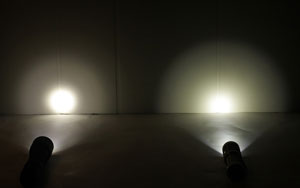Firearms in America
I do my best to provide unbiased information pertaining to different types of firearms, manufacturers, and laws. Certain sections of this site focus on specific areas and topics related to firearms. I only post information on topics and items that I can speak intelligently about. If I am not educated on a specific topic or item then you will not find it here.
Now for the disclaimers; I am not a gunsmith, lawyer, law enforcement officer, or gun control lobbyist. Nor do I play one on television. Any information contained on this site contains no warranty or guarantee of any kind. This site exists for the sole purpose of being useful to those who are less educated about firearms.
SUPPRESSORS: 3 lug barrel mount
Here is a quick look at the 3 lug mount for an Silcencerco/SWR Octane suppressor in 9mm.
Hawaii gun laws and violence
Hawaii calmly flies under the radar with it comes to guns. While New York and California are well-known for strict gun laws, Hawaii isn't any better.
Here are some facts regarding Hawaii and its guns laws as of June 22, 2014. First, while concealed carry permits exist they are actually issued less than California permits. While Hawaii is a "may-issue" state, they actually practice "no-issue." There are no known Hawaii concealed carry permits. In March of 2014, the no-issue practice was deemed unconstitutional but still remains in effect until an appeal is heard.
Hawaii does not recognize any out of state concealed permits. 20 other U.S. states would honor a Hawaii permit for anyone who was able to obtain one. Open carry is legal with a concealed carry permit but again, since no concealed carry permits exist, it is not done.
All gun purchases (both long guns and hand guns) require a permit to purchase. These permits are issued by the chief law enforcement officer (CLEO). Once purchased, any firearms must be also registered with the CLEO within 5 days, and there is no fee for doing so. NFA items known as Destructive Devices (DD) and Any Other Weapon (AOW) are exempt from local registration as they require federal registration with the ATF.
Suppressors, short barrel rifles,short barrel shotguns, and machine guns while legal at the federal level are not permitted in Hawaii. Magazines with a capacity of larger than 10 rounds are also not permitted in Hawaii.
Many anti-gun supporters will boast that Hawaii's gun laws have successfully curbed violence. While there is no way confirm or deny such statement, the fact remains it does have very low rates of violent crime. However, Hawaii has one of the largest drug problems in the United States.
Hawaii judge Steven Alm explains that "Hawaii is always one of the lower states for violent crime. Usually in the bottom 10, but Hawaii is almost always in the top 5 for property crimes." Judge Alm estimates that 80-85% of court cases in Hawaii involve drugs or alcohol. In 2011, 50.8% of men arrested in Honolulu tested positive for Meth.
So while victims are not being physically assaulted, theft is off the charts as drug addicts steal anything of value to fund their habit. Once could make the argument that allowing responsible citizens easier access to guns could reduce theft. Nobody knows for sure but generally when criminals know there is a lower chance of gun ownership, they are more likely to commit crimes against others.
Flashlights: the truth behind lumens
Since LEDs started powering lights we have seen a huge emphasis on something called "lumens." It is a unit of measurement that quantifies how much light is perceived by the human eye. Previously, another popular unit of measurement known as candlepower (technically known as candela) was used. This article will explore the use of lumens as a measurement of modern flashlights.
I will have to get a little technical to better explain why lumens became the replacement for candlepower. Lumen is a unit of measurement that is derived from luminous flux. Luminous flux is a weighted measurement. Meaning, it takes more things into account than just beam intensity. The use of LEDs (Light Emitting Diode) has created a much larger spectrum of light than older incandescent light bulbs.
When non-visible (infrared) and Ultra-violet light is measured along with visible light, it is called radiant flux. Luminous flux measures the entire spectrum of visible light only. Taking into account only what the human eye can see which is around 560 nanometers in wavelength. Some lights are appear "whiter" than others therefore having a higher lumen rating. It's important to understand that one light may be rated almost double the lumens over another but not actually appear twice as "bright."

Along with the color of the beam, the angle or "spill" can be different which also affects the lumen rating. A more focused (less spill) will have a higher lumen rating than less focused (more spill) light. It's also important to know that different manufacturers will measure their lights different ways. Some (like Surefire) will measure light spherically using multiple photometers which give the most honest lumen rating.
So what about a $35 weapon light that claims to have the same similar lumen ratings as the $235 light? In most cases, the low-end light is measured in candela units through a tube or cone. Using this method yields the "best" candela rating which is then converted to lumens. In such case, you actually have an apples to oranges situation which then misleads unsuspecting consumers.
If you want a quality light be it weapon mounted or handheld, you will need to spend some money. Most manufacturers of quality lights provide a lifetime warranty. I recommend lights such as the Surefire Ultra High Output LED, Streamlight TLR-1 HL, and FOURSEVENS Maelstrom
.
 12/01/11 11:19:00 am,
12/01/11 11:19:00 am, 